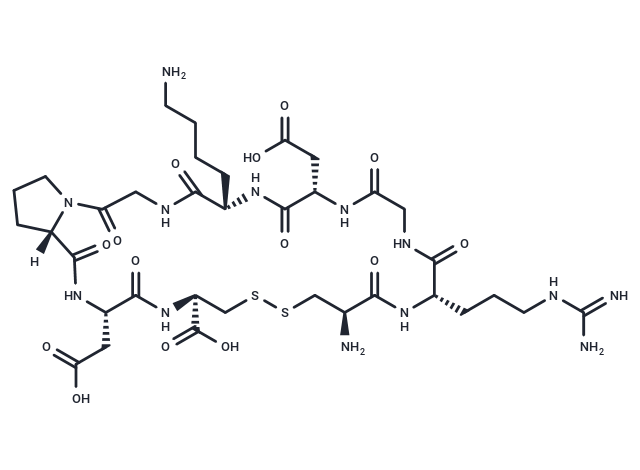Shopping Cart
Remove All Your shopping cart is currently empty
Your shopping cart is currently empty
iRGD peptide (c(CRGDKGPDC)) is a 9-amino acid cyclic peptide (sequence: CRGDKGPDC) and a molecular mimicry agent that was originally identified in an in vivo screening of phage display libraries in tumor-bearing mice.

| Pack Size | Price | USA Warehouse | Global Warehouse | Quantity |
|---|---|---|---|---|
| 1 mg | $72 | In Stock | In Stock | |
| 5 mg | $297 | In Stock | In Stock | |
| 10 mg | $513 | In Stock | In Stock | |
| 25 mg | $819 | In Stock | In Stock | |
| 50 mg | $1,090 | In Stock | In Stock | |
| 100 mg | $1,490 | In Stock | In Stock |
| Description | iRGD peptide (c(CRGDKGPDC)) is a 9-amino acid cyclic peptide (sequence: CRGDKGPDC) and a molecular mimicry agent that was originally identified in an in vivo screening of phage display libraries in tumor-bearing mice. |
| In vitro | iRGD peptide-mediated tumor penetration involves a three-step process: initial binding to αv-integrins present on tumor vasculature or cells, the revelation of a C-terminal motif capable of binding to neuropilin-1 (NRP-1) through proteolysis, and subsequent cell internalization. Incorporation of the iRGD peptide into the ICOVIR15K fiber's C terminus specifically improves binding and internalization in MCF7 cells, known to express NRP-1 and integrins, without affecting the virus's ability to infect and replicate[1]. Alone, the iRGD peptide does not significantly impact gastric cancer cells. However, when combined with 5-FU, it notably enhances the chemotherapy's efficacy against gastric cancer cells via NRP1, at a concentration of 0.3 μmol/mL[2]. |
| In vivo | iRGD inserted in the oncolytic adenovirus ICOVIR15K (ICOVIR15K-iRGD) enhances early adenovirus dissemination through the tumor mass and elevates the antitumor effect in mice[1]. In vivo, iRGD did not alter the normal organ transduction pattern, with liver and spleen as main targeted organs. iRGD (4 mmol/kg, i.v.) combined with 5-FU significantly suppresses tumor growth in nude mice bearing human gastric cancer cells[2]. |
| Synonyms | c(CRGDKGPDC) |
| Molecular Weight | 948.04 |
| Formula | C35H57N13O14S2 |
| Cas No. | 1392278-76-0 |
| Smiles | O=C1[C@]2(N(CCC2)C(=O)CNC(=O)[C@H](CCCCN)NC(=O)[C@H](CC(O)=O)NC(=O)CNC(=O)[C@H](CCCNC(=N)N)NC(=O)[C@@H](N)CSSC[C@@H](C(O)=O)NC(=O)[C@H](CC(O)=O)N1)[H] |
| Relative Density. | 1.68 g/cm3 (Predicted) |
| Color | White |
| Appearance | solid |
| Sequence | Cys-Arg-Gly-Asp-Lys-Gly-Pro-Asp-Cys (Disulfide bridge:Cys1-Cys9) |
| Sequence Short | CRGDKGPDC (Disulfide bridge:Cys1-Cys9) |
| Storage | keep away from moisture | Powder: -20°C for 3 years | In solvent: -80°C for 1 year | Shipping with blue ice/Shipping at ambient temperature. | ||||||||||||||||||||
| Solubility Information | DMSO: Insoluble H2O: 10 mM, Sonication is recommended. | ||||||||||||||||||||
Solution Preparation Table | |||||||||||||||||||||
H2O
| |||||||||||||||||||||
| Size | Quantity | Unit Price | Amount | Operation |
|---|

Copyright © 2015-2025 TargetMol Chemicals Inc. All Rights Reserved.